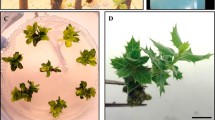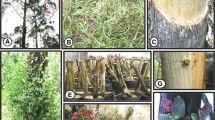Abstract
Holm oak (Quercus ilex L.), a typical evergreen tree of the Mediterranean area, is very important due to its ecological and economical values. Propagation of this species is extremely difficult and traditionally carried out only by seed germination. In this work, mature acorns were germinated in vitro and in peat substrate in aseptic and non-aseptic conditions. Explants from the seedlings obtained were propagated in vitro in WPM plus 4 µM BA. Plant regeneration was achieved from hypocotyls and root segments cultured in vitro on modified Gamborg medium plus 20 µM BA and 20 µM NAA. 13.8% of the hypocotyls and approximately 30% of the root segments developed both shoots and roots after 30 days of culture. Rooting of stem segments was obtained both in vitro and ex vitro by basal dipping in IBA solutions. Within ex vitro rooting, mother plant age had major influence on the percentage of rooting of the cuttings as the younger plants showed higher ability to root. In this way, Q. ilex plants could be propagated and cloned. The procedure described here would be a very useful tool for breeding programs since vegetative propagation of selected individuals can be achieved.
Similar content being viewed by others
Abbreviations
- BA:
-
benzyladenine
- IBA:
-
indole-3-butyric acid
- MS:
-
Murashige and Skoog medium
- NAA:
-
a-naphthalene acetic acid
- PVC:
-
polyvinyl chloride
- WPM:
-
woody plant medium
References
Mauri P.V., Manzanera J.A., Induction, maturation and germination of holm oak (Quercus ilex L.) somatic embryos, Plant Cell Tissue Organ Cult., 2003, 74, 229–235
Pascual G., Molinas M., Verdaguer D., Comparative anatomical analysis of the cotyledonary region in three Mediterranean Basin Quercus (Fagaceae), Am. J. Bot., 2002, 89, 383–392
Plieninger T., Pulido F.J., Konold W., Effects of land-use history on size structure of holm oak stands in Spanish dehesas: implications for conservation and restoration, Environ. Conserv., 2003, 30, 61–70
Shakesby R.A., Coelho C.O.A., Schnabel S., Keizer J.J., Clarke M.A., Contador J.F.L., et al., A ranking methodology for assessing relative erosion risk and its application to dehesas and montados in Spain and Portugal, Land Degrad. Dev., 2002, 13, 129–140
Puerta-Piñero C., Gómez J.M., Zamora R., Species-specific effects on topsoil development affect Quercus ilex seedling performance, Acta Oecol., 2006, 29, 65–71
Pulido F.J., Diaz M., Regeneration of a Mediterranean oak: A whole-cycle approach, Ecoscience, 2005, 12, 92–102
Brasier C.M., Phytophthora cinnamomi and oak decline in southern Europe. Environmental constraints including climate change, Ann. Sci. Forest., 1996, 53, 347–358
Gallego F.J., de Algaba A.P., Fernandez-Escobar R., Etiology of oak decline in Spain, Eur. J. Forest Pathol., 1999, 29, 17–27
Soto A., Lorenzo Z., Gil L., Differences in fine-scale genetic structure and dispersal in Quercus ilex L. and Q. suber L.: consequences for regeneration of mediterranean open woods, Heredity, 2007, 99, 601–607
L’Helgoual’ch M., Espagnac H., First observations on the adventitious rhizogenic capacity of holm oak (Quercus ilex L.), Ann. Sci. Forest., 1987, 44, 325–334
Sánchez M.C., San José M.C., Ballester A., Vieitez A.M., Requirements for in vitro rooting of Quercus robur and Quercus rubra shoots derived from mature trees, Tree Physiol., 1996, 16, 673–680
Murashige T., Skoog F., A revised medium for rapid growth and bio-assays with tobacco tissue cultures, Physiol. Plant., 1962, 15, 473–497
Lloyd G.B., McCown B.H., Use of microculture for production and improvement of Rhododendron spp, Hortscience, 1980, 15, 416–417
Gamborg O.L., Miller R.A., Ojima K., Nutrient requirements of suspension cultures of soybean root cells, Exp. Cell Res., 1968, 50, 151–158
García L.V., Controlling the false discovery rate in ecological research, Trends Ecol. Evol., 2003, 18, 553–554
Pierik R.L.M., In vitro Culture of Higher Plants, Martinus Nijhoff Publishers, Dordrecht, Netherlands, 1987
Gonzalez-Benito M.E., Prieto R.M., Herradon E., Martin C., Cryopreservation of Quercus suber and Quercus ilex embryonic axes: In vitro culture, desiccation and cooling factors, CryoLetters, 2002, 23, 283–290
Mauri P.V., Manzanera J.A., Effect of abscisic acid and stratification on somatic embryo maturation and germination of holm oak (Quercus ilex L.), In Vitro Cell. Dev. Plant, 2004, 40, 495–498
Broncano M.J., Riba M., Retana J., Seed germination and seedling performance of two Mediterranean tree species, holm oak (Quercus ilex L.) and Aleppo pine (Pinus halepensis Mill.): a multifactor experimental approach, Plant Ecol., 2004, 138, 17–26
Cortes P., Espelta J.M., Savé R., Biel C., Effects of a nursery CO2 enriched atmosphere on the germination and seedling morphology of two Mediterranean oaks with contrasting leaf habit, New Forest., 2004, 28, 79–88
Gómez J.M., Importance of microhabitat and acorn burial on Quercus ilex early recruitment: non-additive effects on multiple demographic processes, Plant Ecol., 2004, 172, 287–297
Pulido F.J., Herbivorismo y regeneración de la encina (Quercus ilex L.) en bosques y dehesas, PhD Thesis, University of Extremadura, Spain, 1999
Pulido F.J., Díaz M., Hidalgo S.J., Size-structure and regeneration of holm oak (Quercus ilex) forest and dehesas: effects of agroforestry use on their long-term sustainability, For. Ecol. Manage., 2001, 146, 1–13
Féraud-Keller C., Espagnac H., Conditions d’apparition d’une embryogénèse somatique sur des cals issus de la culture de tissus foliaires du chêne vert (Quercus ilex) (Conditions for the appearance of somatic embryogenesis on callus from leaf tissue cultures of holm oak (Quercus ilex)), Can. J. Bot., 1989, 67, 1066–1070, (in French)
Kormanik P.P., Brown C.L., Vegetative propagation of some selected hardwood forest species in the south eastern United States, New Zeal. J. Forest. Sci., 1974, 4 228–234
Author information
Authors and Affiliations
Corresponding author
About this article
Cite this article
Liñán, J., Cantos, M., Troncoso, J. et al. Some propagation methods for cloning holm oak (Quercus ilex L.) plants. cent.eur.j.biol. 6, 359–364 (2011). https://doi.org/10.2478/s11535-011-0007-y
Received:
Accepted:
Published:
Issue Date:
DOI: https://doi.org/10.2478/s11535-011-0007-y




